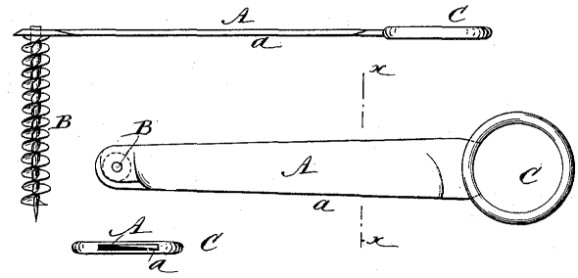 |
 The Virtual Corkscrew Museum's Weekly Newspaper |
 |
 |
 The Virtual Corkscrew Museum's Weekly Newspaper |
 |
|
Sunday, September 9, 2007 |
Number 477 |
Food Tools - Part 4
Quirls by Bob Roger
Every Victorian kitchen had quirls to 'fancy up' the presentation of food. Quirls are another name for garnishers. They were used for cutting spiral shapes from root vegetables (e.g. potatoes, beets, parsnips, turnips, carrots), fruit, etc. for ornamentation, pickling, or frying).
Blaettler Patent
Vuillier Patent
On March 19, 1872 John Blaettler of Philadelphia was issued U. S. patent number 124,782 for a device for cutting food into coils. His quirl has a single closed cutting edge attached to an auger-pointed shaft. Although a circular cutting edge is shown in the patent, he claims circular, cross, star, and other shapes, and assigned the patent to Herman Meyer of Philadelphia.
On February 16, 1875 Aime Vuillier of Newark, New Jersey, was issued U. S. patent number 159,869 for a similar tool having two cutting loops.
With both of these implements, the cut spiral coils itself up the shaft as the auger point pulls the tool into the vegetable. To remove the spiral in one piece, the handle is removed and the spiral slid off the end of the shaft. The handle, therefore, was made to easily slide on and off, and therefore often was separated from the tool itself. That is why these items are usually found missing the handle.

Massari Patent
Another style, patented on June 19, 1883 (number 279,782) by Silvio Massari of Columbus, Ohio, consists of a sharp blade with a loop for the finger and a screw on the end, mounted at 90 degrees to the blade. The vegetable is held in the left hand, and the screw turned into it by revolving the cutter around the vegetable. As the screw pulls into the vegetable the knife cuts a spiral slice.
Bissig Patent
In 1888 Bissig replaced the finger loop with a small handle and received patent number 384,738 for it.
Bob Roger's Quirls
The top example (shown above) is Blaettler's patent with a three-arc cutter and handle at left. The middle example is Vuillier's patent without a handle. Both are marked GERMANY. The bottom example is Massari's patent and is marked POPEIL PRODUCT.
Potato Follow-up
In the August 19 issue, we featured some tools for potatoes. Here are a some additions.
Stone's Patent
Here's a combination tool patented by John Stone that includes "A green-corn grater, vegetable parer and gouge, and a corkscrew". Stone notes that the gouge can be used for removing eyes and specks from potatoes and other vegetables. Convinced that all reading his application would understand the corkscrew, he simply wrote "The use of the corkscrew is apparent." U. S. Patent No. 342,884 was granted June 1, 1886.
Welsh's Patent
Hamilton Welsh went much further than Stone with his combination tool that includes a can opener, knife (for potato eyes and the like), knife sharpener, ear-corn grater or fish-scaler, paring tool, screw-driver, wrench, gimlet, and corkscrew. U. S. Patent No. 597,345 was granted January 11, 1898.
Smith's Patent
Even more elaborte is Alva Smith's combination tool which includes an extension "designed especially for removing cores or specked portions from fruite or the eyes from potatoes for planting." Alva also has a paring tool, corkscrew, can opener, scale, and glass cutter. U. S.. Patent No. 601,737 was granted April 5, 1898.
Silaj's Patent
A "Combination Shrimp Cleaner and Culinary Implement" was designed by Thomas Silaj in 1935. Not only does his tool have a shrimp cleaner but it also serves as an oyster and clam opener, a bottle opener, a corkscrew, an edge for "peeling potatoes, apples, peaches, and other fruits", an apple corer, and an ice pick. U. S.. Patent No. 2,039,850 was granted May 5, 1936.
|
©2007 Don Bull, Editor |